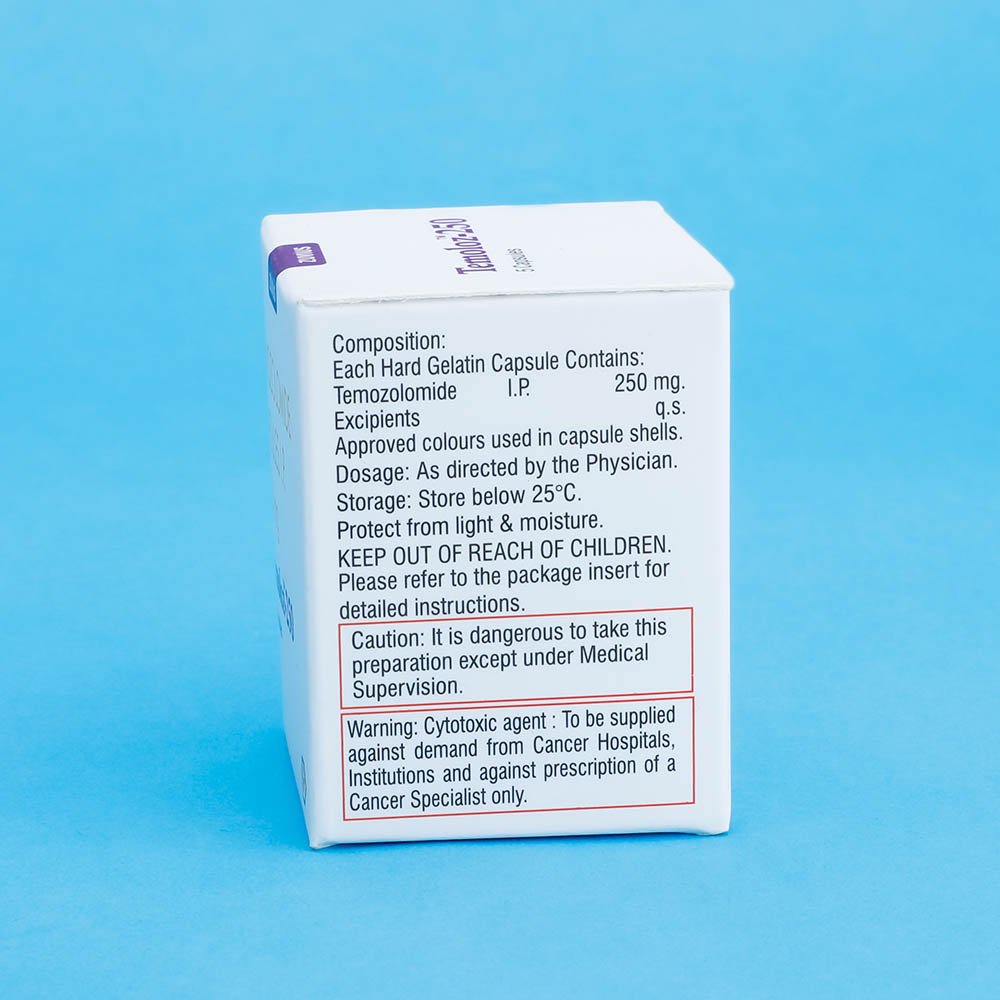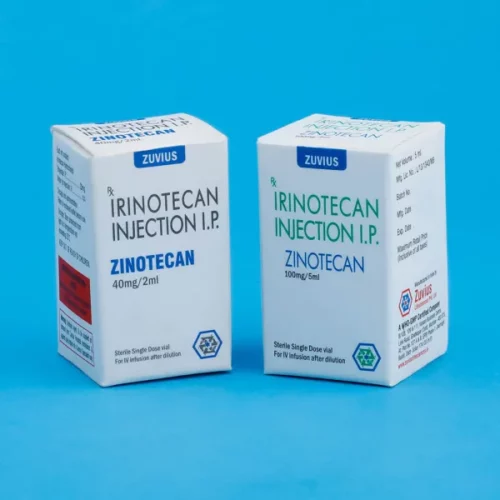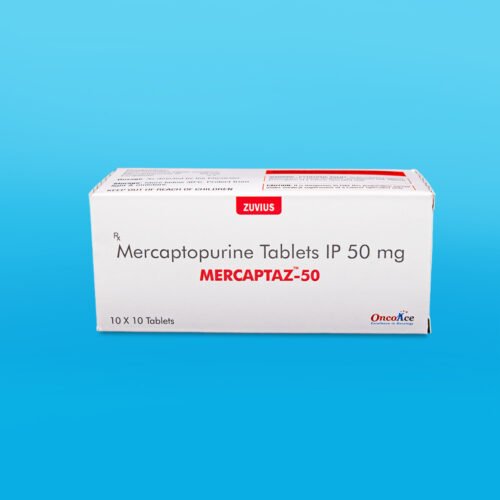Temoloz Cap- Temozolamide Cap
Temozolamide Cap
Strength: 20mg / 100mg / 250mg
Pack Size: 1 x 5
Drug Class: alkylating agents
Dosage and Administration:
Dosage of TEMOLOZ Capsules must be adjusted according to nadir neutrophil and platelet counts in the previous cycle and the neutrophill and plated counts at the time of initiating the next cylce.
Patients with newly diagnosed high grade glioma:
Concomitant Phase : TEMOLOZ is administered orally at 75 mg/m2 daily for 42 days concomitant with focal radiotherapy (60 Gy administered in 30 fractions) followed by maintenance TEMOLOZ for 6 cycles. Focal RT includes the tumor bed or resection site with a 2-3 cm margin. No dose reductions are recommended during the concomitant phase; however, dose interruptions or discontinuation may occur based on toxicity. The TEMOLOZ dose should be continued throughtout the 42 day concomitant period up to 49 days if all of the following conditions are met; absolute neutrophil count> 1.5 x 102/L platelet count> 100X102/L common toxicity criteria (CTC) non-hematological toxicity<Grade 1 (except for alopecia, nausea and vomiting.)
Maintenance Phase Cycle 1: Four weeks after completing the TEMOLOZ + RT PHASE, TEMOLOZ is administered for an additional 6 cycles of maintenance treatment. Dosage in Cycle 1 (maintenance) is 150 mg/m2 once daily for 5 days followed by 23 days without treatment.
Cycles 2-6 : At the start of Cycle 2, the dose is escalated to 200 mg/m2, if the CTC non-hematologic toxicity for Cycle 1 is Grade <2 (except for alopecia, nausea and vomiting), absolute neutrophil count (ANC) is >1.5 x102/L, and the platelet count is >100×102/L. The dose remains at 200 mg/m2 per day for the first 5 days of each subsequent cycle except if toxicity occurs. If the dose was not escalated at Cycle 2, escalation should not be done in subsequent cycles.
Dose reduction or discontinuation during maintenance
Dose reductions during the maintenance phase should be applied according to tables 1 and 2.
Patients with refractory analplastic astrocytoma
For adults the initial dose is 150 mg/m2 orally once daily for 5 consecutive days per 28-days treatment cycle. For adult patients, if both the nadir and day of dosing (Day 29, Day 1 of next
Table 1 Temozolomide Dose Levels for Maintenance Treatment.,
| Dose Level | Dose mg/m2/day | Remarks |
|---|---|---|
| 1 | 100 | Reduction for Prior toxicity. |
| 0 | 150 | Dose during Cycle 1 |
| 1 | 200 | Dose during Cycles 2-6 in absence of toxicity. |
Table 2 Temozolomide Dose Reduction or Discontinuation During Maintenance Treatment.
| Toxicity | Reduce TMZ by 1 Dose Level | Discontinue TMZ |
|---|---|---|
| Absolute Neutrophill Count | <1.0x 109/L | See footnote b |
| Platelet Count | <50×109/L | See footnote b |
| CTC Non-hematological Toxicity (except for alopecia, nausea, vomiting) |
CTC Grade 3 | CTC Grade 4b. |
a: TMZ dose level are listed in 6.
b: TMZ is to be discontinued if dose reduction to <100 mg/m2 is required or if the same Grade 3
non-hematological toxicity (except for alopecia, nausea, vomiting ) recurs after dose reduction.
TMZ= temozolomide; CTC = Common Toxicity Criteria.
cycle) ANC are > 1.5×109/L (1,500/uL) and both the nadir and Day 29, Day 1 of next cycle platelet counts are> 100×109/L (1,00,000/uL), the TEMOLOZ dose may be increased to 200 mg/m2/day for 5 consecutive days per 28-day treatment cycle. During treatment, a complete blood count should be obtained on Day 22 (21 days after the first dose) or within 48 hours of that day , and weekly until the ANC is above 1.5×109/L (50,000/uL) during any cycle, the next cycle should be reduced by 50 mg/m2, but not below 100 mg/m2, the lowest recommended dose. TEMOLOZ therapy can be continued until disease progression. In the clinical trial, treatment could be continued for a maximum of 2 years; but the optimum duration of therapy is not known.
Handling and Disposal
TEMOLOZ causes the rapid appearance of malignant tumors in rats. Capsules should not be opened. If capsules are accidentally opened or damaged, rigorous precautions should be taken with the capsule contents to avoid inhalation or contact with the skin or mucous membranes Procedures for proper handling and disposal of anticancer drugs should be considered. Several guidelines on this subject have been published. There is no general agreement that allof the procedures recommended in the guidelines are necessary or appropriate.
Administration of TEMOLOZ
Patients should take each days with a full glass of water at the same time each day. Taking the medication on an empty stomach or at bedtime may help ease nausea. If patients are also taking antinausea or other medications to relieve the side effects associated with TEMOLOZ, they should be advised to take these medications 30 minutes before they take TEMOLOZ . Temozolomide causes the rapid appearance of malignant tumors in rats. Patients should not open or split the capsules. If capsules are accidentally opened or damaged, rigorous precautions should be taken with the capsule contents to avoid inhalation or contact with the skin or mucous membranes. The medication should be kept away from children and pets. The TEMOLOZ capsules should be swallowed whole and NEVER CHEWED.
Cold Storage: no
Temozolomide Capsules for oral administration contain Temozolomide, an imidazotetrazine derivative. The chemical name of Temozolomide is 3, 4-dihydro-3-methyl-4-oxoimidazo[5, 1-d]-as-tetrazine-8-carboxamide. The structural formula is:
TEMOLOZ (Temozolomide) Capsules are indicated for the treatment of adult patients with newly diagnosed glioblastoma multiforme concomitantly with radiotherapy and then as maintenance treatment.
TEMOLOZ Capsules are indicated for the treatment of adult patients with refractory anaplastic astrocytoma, i.e. patients who have experienced disease progression on a drug regimen containing nitrosurea and procarbazine.
– adult patients with newly-diagnosed glioblastoma multiforme concomitantly with radiotherapy (RT) and subsequently as monotherapy treatment.
– children from the age of three years, adolescents and adult patients with malignant glioma, such as glioblastoma multiforme or anaplastic astrocytoma, showing recurrence or progression after standard therapy.
- Patients with Severe Hepatic or Renal Impairment : Caution should be exercised when TEMOLOZ Capsules are administered to patients with severe hepatic or renal impairment.GeriatricsCaution should be exercised when treating elderly patients. In newly diagnosed patients with glioblastoma multiforme the adverse event profile was similar in younger patients (<65 years) vs older (>65 years)Laboratory TestsFor the concomitant treatment phase with RT a complete blood count should be obtained weekly.For the 28 day treatment cycles, a complete blood count should be obtained on Day 22 (21 days after the first dose). Blood counts should be performed weekly until recovery if the ANC falls below 1.5 x 109/L and the platelet count falls below 100×109/L.Carcinogenesis, Mutagenesis, and impairment of Fertility.Standard carcinogenicity studies were not conducted with temozolomide. In rats treated with 200mg /m2 temozolomide (equivalent to the maximum recommended daily human dose) on 5 consecutive days every 28 days for 3 cycles, mammary carcinomas were found.Temozolomide was mutagenic in Vitro in bacteria (Ames assay) and clastogenic in mammalian cells (human peripheral blood lymphocyte asays).Reproductive function studies have not been conducted with temozolomide. However, multicycle toxicology studies in rats and dogs have demostrated testicular toxicity (syncytial cells/immature sperm, testicular atophy) at doses of 50mg/m2 in dogs (1/4 and 5/8, respectively, of the maximum recommended human dose or a body surface area basis).Pregnancy Category D: See WARNING Section.Nursing Mothers
It is not known whether this drug is excreted in human milk. Because many drugs are excreted in human milk and because of the potential for serious adverse reactions in nursing infants from TEMOLOZ Capsules, patients receiving TEMOLOZ should discontinue nursing.
PEDIATRIC USE
TEMOLOZ effectiveness in children has not been demostrated. The TEMOLOZ toxicity profile in children is similar to adults.
Elderly patients (> 70 years of age)
Elderly patients appear to be at increased risk of neutropenia and thrombocytopenia, compared with younger patients. Therefore, special care should be taken when TMZ is administered in elderly patients.
Female patients
Women of childbearing potential have to use effective contraception to avoid pregnancy while they are receiving TMZ, and for at least 6 months following completion of treatment.
Male patients
Men being treated with TMZ should be advised not to father a child for at least 3 months after receiving the last dose and to seek advice on cryoconservation of sperm prior to treatment





















